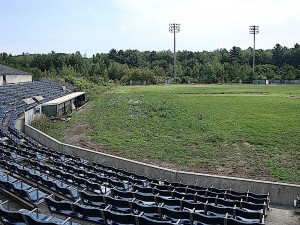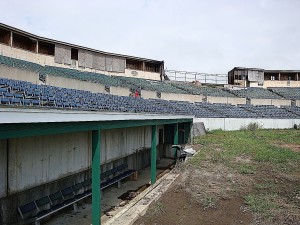We were sitting in the front row, between the backstop and the home dugout at The Ballpark in Old Orchard Beach, Maine.
Bob Moody, assistant coach of the Old Orchard Beach Raging Tide, tossed a baseball to my son, Jack. This transaction took place during the hometown team’s Futures Collegiate Baseball League playoff game against the visiting Martha’s Vineyard Sharks.
I like the symbolism of Moody’s gesture, the inter-generational connection of it.
My first visit to The Ballpark occurred in 1984 when the stadium was new and host to the Triple-A Maine Guides. Jack’s first visit was in 2008 – 20 years after minor-league baseball abandoned The Ballpark.
Jack and I were back at The Ballpark on Aug. 12 to witness a collegiate summer baseball league game. The Ballpark is back, too, after decades of neglect and decay.
‘Otis, my man!’
As Jerry Seinfeld has said, fan loyalty is hard to justify with players changing teams and teams changing cities as often as they do.
“You’re actually rooting for the clothes when you get right down to it,” he said.
Or in this case rooting for a ballpark. The Ballpark.
To understand the fickle nature of professional sports, look no further than the late, great Guides and how Old Orchard Beach found itself with a team in 1984 and without one in 1989.
The short version is that a Bangor, Maine, attorney named Jordan Kobritz bought the International League’s Charleston (W.Va.) Charlies and moved them to Maine. He built a modest stadium in a short period of time, carved out of a pine forest on a 50-acre site.
Even though Old Orchard Beach was a small market (6,400 year-round residents in 1984, according to Sports Illustrated) just south of the state’s biggest city, Portland, the thinking was that tourists would help fill the stands.
To be sure, the Guides ranked fourth in league attendance in the inaugural season of 1984, drawing 183,300 fans. This was four years before the movie “Bull Durham” helped to spark a renewed interest in minor-league baseball and an unprecedented ballpark building boom.
The Guides lost in the championship series. I attended one of the playoff games with my high school friends. Invoking a scene from “Animal House,” we encouraged Guides outfielder Otis Nixon with cheers of “Otis, my man!” Gary Thorne, a part-owner, called Guides games on the radio.
But even a glowing feature story in Sports Illustrated (“The best little AAA park in the game”) couldn’t prevent a quick decline in fan support. In Year 2, attendance dropped by 50,000. By Year 5, with Kobritz out as owner and the team playing as the lame-duck Maine Phillies, only 80,000 fans came out. (I turned 21 that summer and celebrated by seeing a concert featuring Bob Dylan and The Alarm at The Ballpark).
Guides moved to Wilkes-Barre/Scranton
It was pretty sad in the end. The fans weren’t coming, but the bugs were. Mosquitos were such a problem that fans visiting the concession stand could help themselves to hits from complimentary cans of bug spray. Phillies pitchers made fires in the bullpen to stay warm and to keep the insects away.
What Old Orchard Beach had done unto Charleston, Lackawanna County, Pa., did unto Old Orchard Beach. The team moved to the Keystone State to became the Wilkes-Barre/Scranton Red Barons (now the Wilkes-Barre/Scranton RailRiders).
I hadn’t been back to The Ballpark until 2008 when, on another family vacation to my native Maine, we visited what remained of the stadium. Some of the primitive luxury boxes were fire-damaged. Weeds covered the entire field. The original plastic seats crackled and popped in the August heat. Oh, and the mosquitoes!
But soon thereafter a group formed to renovate The Ballpark, which resulted in the relocation of the Lowell (Mass.) All-Americans to Old Orchard Beach for 2011. Originally in the New England Collegiate Baseball League, the team has spent the past two seasons in the Futures Collegiate Baseball League. (New England also boasts the most prestigious summer league of all, the Cape Cod Baseball League, which has been the subject of at least one book, a documentary and a Hollywood movie.)
The FCBL has nine teams: five in Massachusetts, two in New Hampshire, and one each in Maine and Connecticut. The Raging Tide roster comprised college players from throughout New England, but also from Florida and California.
Not only does summer baseball give college players more reps, but the use of wood bats gives major league scouts a truer sense of what hitters and pitchers can do.
Dizzy bat races and T-shirt tosses
For fans, the experience is not unlike attending a minor-league game, certainly comparable with the Maine Guides era. The Raging Tide offers food and merchandise stands, dizzy bat races and T-shirt tosses.
The Raging Tide placed sixth in attendance this season, drawing 13,647 fans for 23 regular-season games: an average of 593 per game. For the playoff game, we were among a crowd of 779.
A 7-3 loss to eventual league champion Martha’s Vineyard meant the end of the Raging Tide’s season. Raging Tide head coach Chris Torres took to a microphone and addressed the remaining fans after the game, lauding his players and thanking the community for its support.
He also said the Raging Tide will return in 2014.





